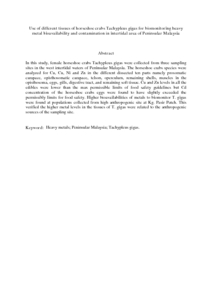Citation
Yap, Chee Kong and Chew, W.
(2013)
Use of different tissues of horseshoe crabs Tachypleus gigas for biomonitoring heavy metal bioavailability and contamination in intertidal area of Peninsular Malaysia.
Pollution Research, 32 (1).
pp. 1-8.
ISSN 0257-8050
Abstract
In this study, female horseshoe crabs Tachypleus gigas were collected from three sampling sites in the west intertidal waters of Peninsular Malaysia. The horseshoe crabs species were analyzed for Cu, Cu, Ni and Zn in the different dissected ten parts namely prosomatic carapace, opisthosomatic carapace, telson, operculum, remaining shells, muscles in the opisthosoma, eggs, gills, digestive tract, and remaining soft tissue. Cu and Zn levels in all the edibles were lower than the max permissible limits of food safety guidelines but Cd concentration of the horseshoe crabs eggs were found to have slightly exceeded the permissibly limits for food safety. Higher bioavailabilities of metals to biomonitor T. gigas were found at populations collected from high anthropogenic site at Kg. Pasir Puteh. This verified the higher metal levels in the tissues of T. gigas were related to the anthropogenic sources of the sampling site.
Download File
![[img]](http://psasir.upm.edu.my/30076/1.hassmallThumbnailVersion/Use%20of%20different%20tissues%20of%20horseshoe%20crabs%20Tachypleus%20gigas%20for%20biomonitoring%20heavy%20metal%20bioavailability%20and%20contamination%20in%20intertidal%20area%20of%20Peninsular%20Malaysia.pdf)  Preview |
|
PDF (Abstract)
Use of different tissues of horseshoe crabs Tachypleus gigas for biomonitoring heavy metal bioavailability and contamination in intertidal area of Peninsular Malaysia.pdf
Download (83kB)
| Preview
|
|
Additional Metadata
Actions (login required)
 |
View Item |

